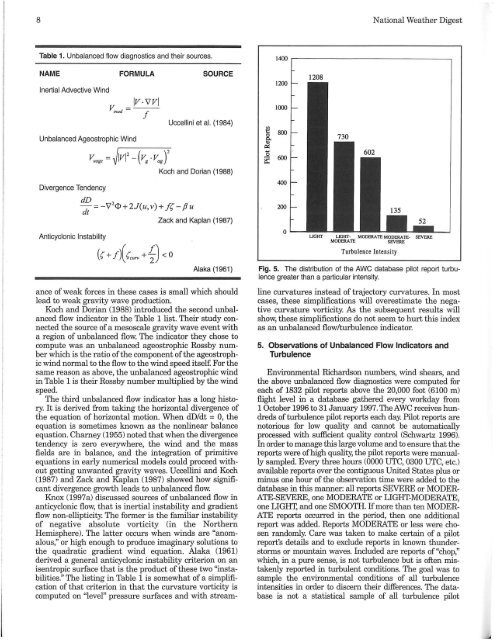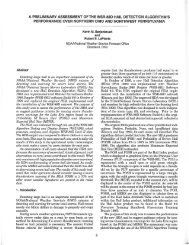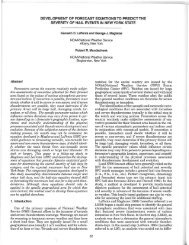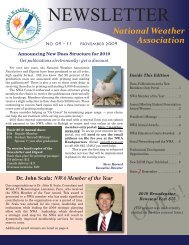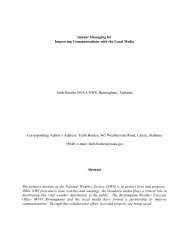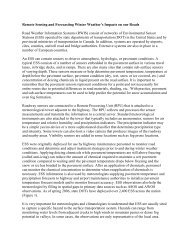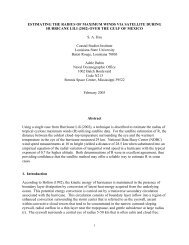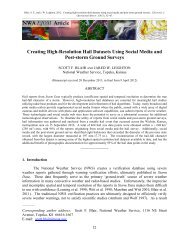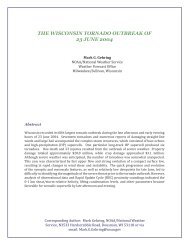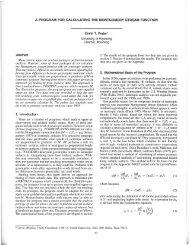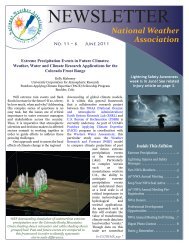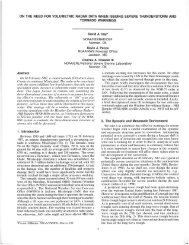gravity waves, unbalanced flow, and aircraft clear air turbulence (1)
gravity waves, unbalanced flow, and aircraft clear air turbulence (1)
gravity waves, unbalanced flow, and aircraft clear air turbulence (1)
Create successful ePaper yourself
Turn your PDF publications into a flip-book with our unique Google optimized e-Paper software.
8<br />
National Weather Digest<br />
Table 1. Unbalanced <strong>flow</strong> diagnostics <strong>and</strong> their sources.<br />
NAME<br />
Inertial Advective Wind<br />
FORMULA<br />
v'nad =<br />
Iv·vvl<br />
I<br />
SOURCE<br />
Uccellini et al. (1984)<br />
Unbalanced Ageostrophic Wind<br />
v',age = ~lvl2 - (V g • v"g r<br />
Koch <strong>and</strong> Dorian (1988)<br />
Divergence Tendency<br />
1400<br />
1200<br />
1000<br />
t.! 800 0<br />
go<br />
~<br />
-~<br />
600<br />
400<br />
1208<br />
Anticyclonic Instability<br />
dD 2<br />
dt = -V ct> + 2J(u, v)+ Is - fJ u<br />
(r; + 1)(Scurv + ~) < °<br />
Zack <strong>and</strong> Kaplan (1987)<br />
Alaka (1961)<br />
ance of weak forces in these cases is small which should<br />
lead to weak <strong>gravity</strong> wave production.<br />
Koch <strong>and</strong> Dorian (1988) introduced the second <strong>unbalanced</strong><br />
<strong>flow</strong> indicator in the Table 1 list. Their study connected<br />
the source of a mesoscale <strong>gravity</strong> wave event with<br />
a region of <strong>unbalanced</strong> <strong>flow</strong>. The indicator they chose to<br />
compute was an <strong>unbalanced</strong> ageostrophic Rossby number<br />
which is the ratio of the component ofthe ageostrophic<br />
wind normal to the <strong>flow</strong> to the wind speed itself For the<br />
same reason as above, the <strong>unbalanced</strong> ageostrophic wind<br />
in Table 1 is their Rossby number multiplied by the wind<br />
speed.<br />
The third <strong>unbalanced</strong> <strong>flow</strong> indicator has a long history.<br />
It is derived from taking the horizontal divergence of<br />
the equation of horizontal motion. When dD/dt = 0, the<br />
equation is sometimes known as the nonlinear balance<br />
equation. Charney (1955) noted that when the divergence<br />
tendency is zero everywhere, the wind <strong>and</strong> the mass<br />
fields are in balance, <strong>and</strong> the integration of primitive<br />
equations in early numerical models could proceed without<br />
getting unwanted <strong>gravity</strong> <strong>waves</strong>. Uccellini <strong>and</strong> Koch<br />
(1987) <strong>and</strong> Zack <strong>and</strong> Kaplan (1987) showed how significant<br />
divergence growth leads to <strong>unbalanced</strong> <strong>flow</strong>.<br />
Knox (1997 a) discussed sources of <strong>unbalanced</strong> <strong>flow</strong> in<br />
anticyclonic <strong>flow</strong>, that is inertial instability <strong>and</strong> gradient<br />
<strong>flow</strong> non-ellipticity. The former is the familiar instability<br />
of negative absolute vorticity (in the Northern<br />
Hemisphere). The latter occurs when winds are "anomalous,"<br />
or high enough to produce imaginary solutions to<br />
the quadratic gradient wind equation. Alaka (1961)<br />
derived a general anticyclonic instability criterion on an<br />
isentropic surface that is the product of these two "instabilities."<br />
The listing in Table 1 is somewhat of a simplification<br />
of that criterion in that the curvature vorticity is<br />
computed on "level" pressure surfaces <strong>and</strong> with stream-<br />
200<br />
0<br />
LlGlIT· MODERAlE MODERAlE· SEVERE<br />
MODERAlE<br />
SEVERE<br />
Turbulence Intensity<br />
Fig. 5. The distribution of the AWe database pilot report <strong>turbulence</strong><br />
greater than a particular intensity.<br />
line curvatures instead of trajectory curvatures. In most<br />
cases, these simplifications will overestimate the negative<br />
curvature vorticity. AB the subsequent results will<br />
show, these simplifications do not seem to hurt this index<br />
as an <strong>unbalanced</strong> <strong>flow</strong>/<strong>turbulence</strong> indicator.<br />
5. Observations of Unbalanced Flow Indicators <strong>and</strong><br />
Turbulence<br />
Environmental Richardson numbers, wind shears, <strong>and</strong><br />
the above <strong>unbalanced</strong> <strong>flow</strong> diagnostics were computed for<br />
each of 1832 pilot reports above the 20,000 foot (6100 m)<br />
flight level in a database gathered every workday from<br />
1 October 1996 to 31 January 1997. TheAWC receives hundreds<br />
of <strong>turbulence</strong> pilot reports each day. Pilot reports are<br />
notorious for low quality <strong>and</strong> cannot be automatically<br />
processed with sufficient quality control (Schwartz 1996).<br />
In order to manage this large volume <strong>and</strong> to ensure that the<br />
reports were of high quality, the pilot reports were manually<br />
sampled. Every three hours (0000 UTC, 0300 UTC, etc.)<br />
available reports over the contiguous United States plus or<br />
minus one hour of the observation time were added to the<br />
database in this manner: all reports SEVERE or MODER<br />
ATE-SEVERE, one MODERATE or LIGHT-MODERATE,<br />
one LIGll, <strong>and</strong> one SMOOTH. Ifmore than ten MODER<br />
ATE reports occurred in the period, then one additional<br />
report was added. Reports MODERATE or less were chosen<br />
r<strong>and</strong>omly. Care was taken to make certain of a pilot<br />
report's details <strong>and</strong> to exclude reports in known thunderstorms<br />
or mountain <strong>waves</strong>. Included are reports of "chop,"<br />
which, in a pure sense, is not <strong>turbulence</strong> but is often mistakenly<br />
reported in turbulent conditions. The goal was to<br />
sample the environmental conditions of all <strong>turbulence</strong><br />
intensities in order to discern their differences. The database<br />
is not a statistical sample of all <strong>turbulence</strong> pilot


